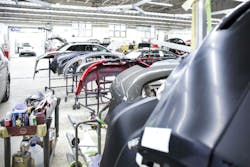Although roll-on primer has been around for a number of years and has numerous advantages, the technique is underutilized by many shops. The largest reason for that, Darrell Amberson says, is that it can seem like it takes more time. And with the increasing adoption of new drying technology, it is becoming easier than ever to roll on primer, rather than spraying. Doing so allows primer to be applied anywhere in the shop, reducing vehicle movement and improving cycle time, says Darrell Amberson, president of operations at the five-location LaMettry’s Collision in the Twin Cities area of Minnesota. Amberson’s shops have been rolling on primer for the past year, and he breaks down the reasons why it has been helpful and his shop’s process for doing so.
There are several advantages to rolling primer on the surface instead of with a spray gun. Overspray is one major reason to consider it. Spraying procedures must be restricted to an area with a controlled atmosphere, such as a paint booth or prep station. The result is that primer operations have to wait for the vehicles to be moved to the paint area. But a liquid applied with a brush or roller produces no overspray, so there are few health or environmental concerns, and very little masking needs to be done. The reduced time spent masking also saves significant amounts of labor time. The more cars you can prime with a roller and the less time you spend cleaning up, the more savings you’ll accrue.
The rolling of primer is dependent on the shape and contour of the vehicle. It simply won’t work in certain areas, like around the fog light. It is generally recommended for smaller areas. Rolling very large areas could result in a more uneven surface from trying to recoat with a roller after the first part coated has flashed.
There is a learning curve associated with doing this and we’ve been dabbling with it for the past year, especially once we invested in the Bodyshop Revolution gas catalytic drying system. We use the smaller handheld drying units to dry body primer. You don’t need an infrared drying system, but it is helpful to speed up the process even more. Other than that, you simply need the primer and a roller. When you roll, you can’t use any roller you want. You can’t go to a home store and buy one because they don’t all work. You have to buy one that’s specifically designed for this kind of paint. While it does take some trial and error to find the best one, I’ve found that the least-textured roller covers work the best. If you use one that’s too coarse of a pad, the primer comes out rough and requires more sanding. Both Bodyshop Revolution and our paint company have been helpful in finding the right type of roller.
We start by mixing the primer—we still utilize our same primer—in a cup, and before you start rolling it on, clean some of it off on the mixing cup. Then start rolling your first coat of primer. You’re just gliding the roller along with minimal pressure. If you have an infrared heat light, use this to dry the primer or allow it to cool off for a little bit. On average, it only takes a couple minutes to cool and then it’s ready for another coat. Then apply the next coat approximately an inch beyond the previous coat. Normally the number of coats depends on how much fill we think we need, but in general, it’s going to be between 3-4 coats. Throughout, make sure you’re not getting any plow lines.
At the end, we take the dry edge of the roller and move it over the outer edge of the primer, pressing it down as you go. The purpose is to press down that outer edge so that it doesn’t create a “stair stepper” effect.
